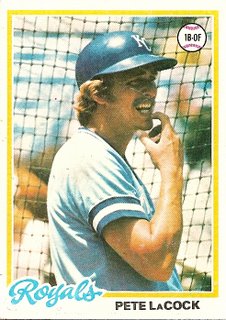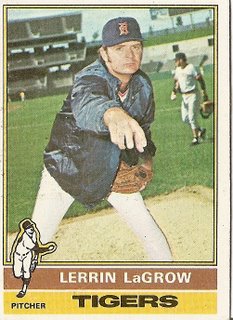Bill Lee
 Unlike most Red Sox hurlers, Bill Lee was good at beating the Yankees. Keenly aware of this, Mickey Rivers and Graig Nettles conspired during a wild 1976 Red Sox-Yankees bench-clearing brawl to ambush Lee and rip his pitching arm out of its shoulder socket. He struggled the next couple of years for the Red Sox and in December 1978 the team, with the blessing of manager Don Zimmer, who hated and was hated by the nonconformist lefty, shipped Lee to the Expos for Stan "Little Papi" Papi, who proceeded to hit a Stan Papiesque .188 for the Red Sox while Lee turned in a classic "fuck you, Red Sox" year, going 16–10 with a 3.04 ERA. His major league career came to an end in 1982 when his one-game walkout to protest the release of teammate Rodney Scott resulted in the Expos showing him the same door they showed Rodney Scott.
Unlike most Red Sox hurlers, Bill Lee was good at beating the Yankees. Keenly aware of this, Mickey Rivers and Graig Nettles conspired during a wild 1976 Red Sox-Yankees bench-clearing brawl to ambush Lee and rip his pitching arm out of its shoulder socket. He struggled the next couple of years for the Red Sox and in December 1978 the team, with the blessing of manager Don Zimmer, who hated and was hated by the nonconformist lefty, shipped Lee to the Expos for Stan "Little Papi" Papi, who proceeded to hit a Stan Papiesque .188 for the Red Sox while Lee turned in a classic "fuck you, Red Sox" year, going 16–10 with a 3.04 ERA. His major league career came to an end in 1982 when his one-game walkout to protest the release of teammate Rodney Scott resulted in the Expos showing him the same door they showed Rodney Scott.My Vermont childhood was coming toward a close around that time. My brother was away at boarding school (rooming with our friend from the Randolph Center days, Buster Olney), and the house adults, Mom and Tom, had both long-since given up on their dream of hippie grow-your-own-food self-sufficiency and had gotten regular full-time jobs, which made the house feel even emptier than it already might have in the glaring absence of my brother. In a couple years we three remainders would all go our separate ways, and maybe on some level we all knew the separation was coming. Maybe that’s why we took our only trip as a threesome around then, a gray weekend visit to Montreal. I can only remember that there didn’t seem to be very much to do on that trip. It was like life in general for me during that twilight time, as if the distractions that had wallpapered over the void for most of my childhood were dissolving.
We wandered the streets, ate in a restaurant where you ordered in French, sat around the hotel, and, in the one gleaming highlight, went to a documentary, which as far as I know was never released in the U.S., about Bill Lee. Here he was in all his glory, talking about sprinkling marijuana on his pancakes, cursing Don Zimmer for his beady-eyed, self-righteous, slow-witted devotion to traditional thinking, lauding meditation as a way to take a snapshot of your mind at any moment, and blaming the chronic back problems that besieged Americans on the fact that we, unlike the more enlightened Japanese, were slavishly devoted to the con game of chairs. With his bushy Expos-era beard and his good-natured motormouth communist rantings, he seemed like one of Mom and Tom’s friends from the old days of the hippie pot-luck suppers and the moonlight brandy-sipping cross-country ski outings.
It makes sense to me that Bill Lee ended up settling post-career in Vermont, maybe the only major leaguer to ever have done so. Not only was it the midpoint between his two major league stops, it was also a land where a bearded iconoclastic weirdo could chairlessly sprinkle marijuana on his pancakes in rustic peace. It makes even more sense that when the Red Sox finally ended their sufferings in 2004 they did so in part by creating a reverse image of their dubious treatment of Lee, acquiring a certain pitcher from Montreal, who though otherwise extremely effective was generally undone by the Yankees, and who in a wild 2003 Yankees-Red Sox brawl deftly hoisted Yankee bench coach Don Zimmer on his own foolish petard. Lee, as usual, was not at a loss for words when asked to comment on Pedro Martinez’s terse deflection of the onrushing Zimmer: "Maybe it knocked some sense into him. It’s pretty hard to grab a bowling ball by the ears. What amazes me is that he didn’t bounce. I would have been sure he was full of helium." One short year later, my brother and I were screaming our voices raw at the happiest parade since VJ Day.
In closing, and apropos of nothing except maybe as a tribute to the way William Francis Spaceman Lee was always spilling over with raw irrational illogical life, I’d just like to add that the back of this card features a space-filling cartoon with a caption that reads as follows: "Pete LaCock is a son of television personality Peter Marshall." It is not the first instance of a major leaguer changing a surname from something potentially offensive, such as Marshall, to something completely immune to mockery, such as LaCock. In the late-1930s a man who had been born John Oscar Dicksus played under the name Johnny Dickshot. If you don't believe me, you can view his "stage name" and career numbers by clicking here. You'll also find a listing of his given name and be able to see that Johnny Dickshot’s nickname was "Ugly."

























